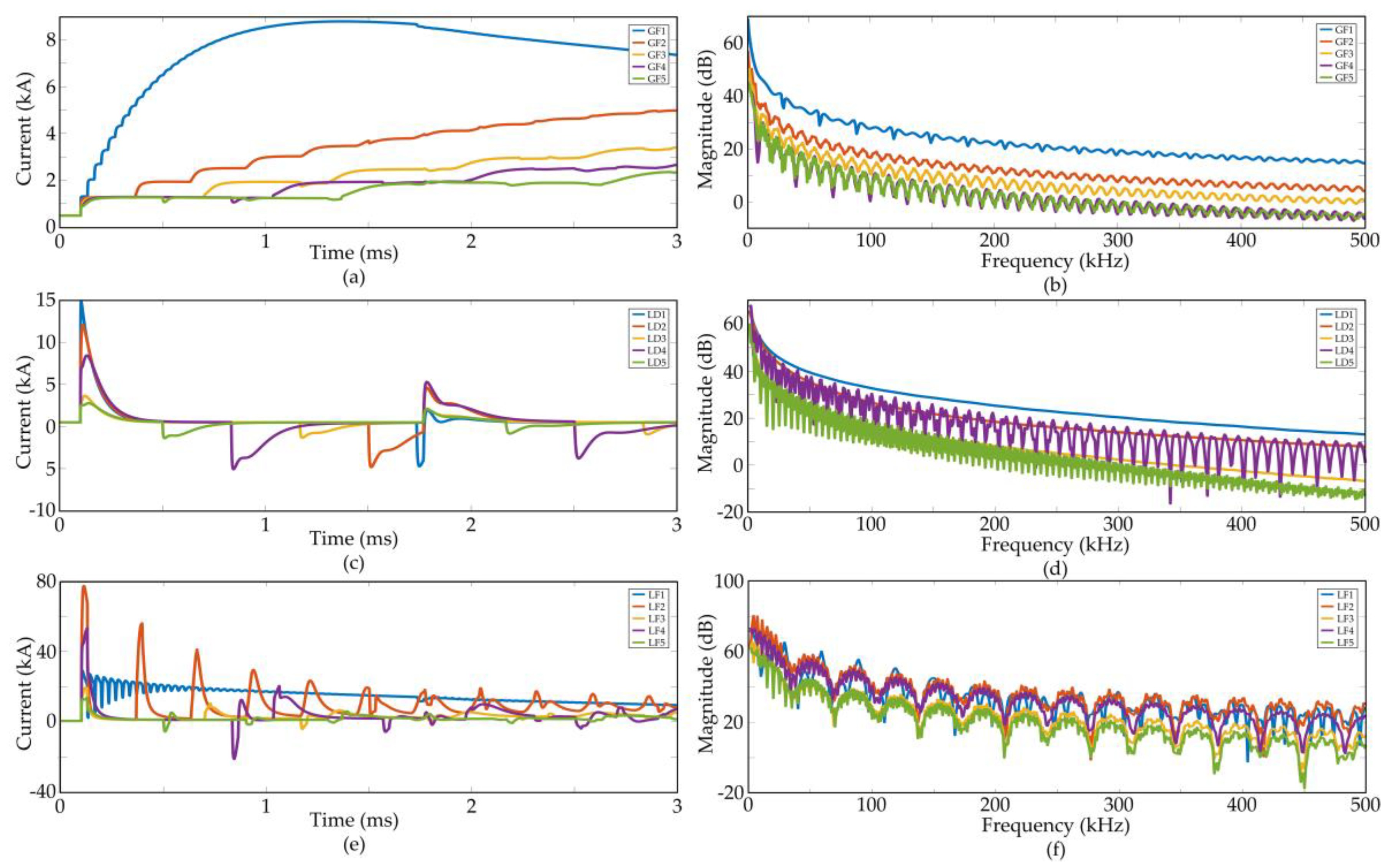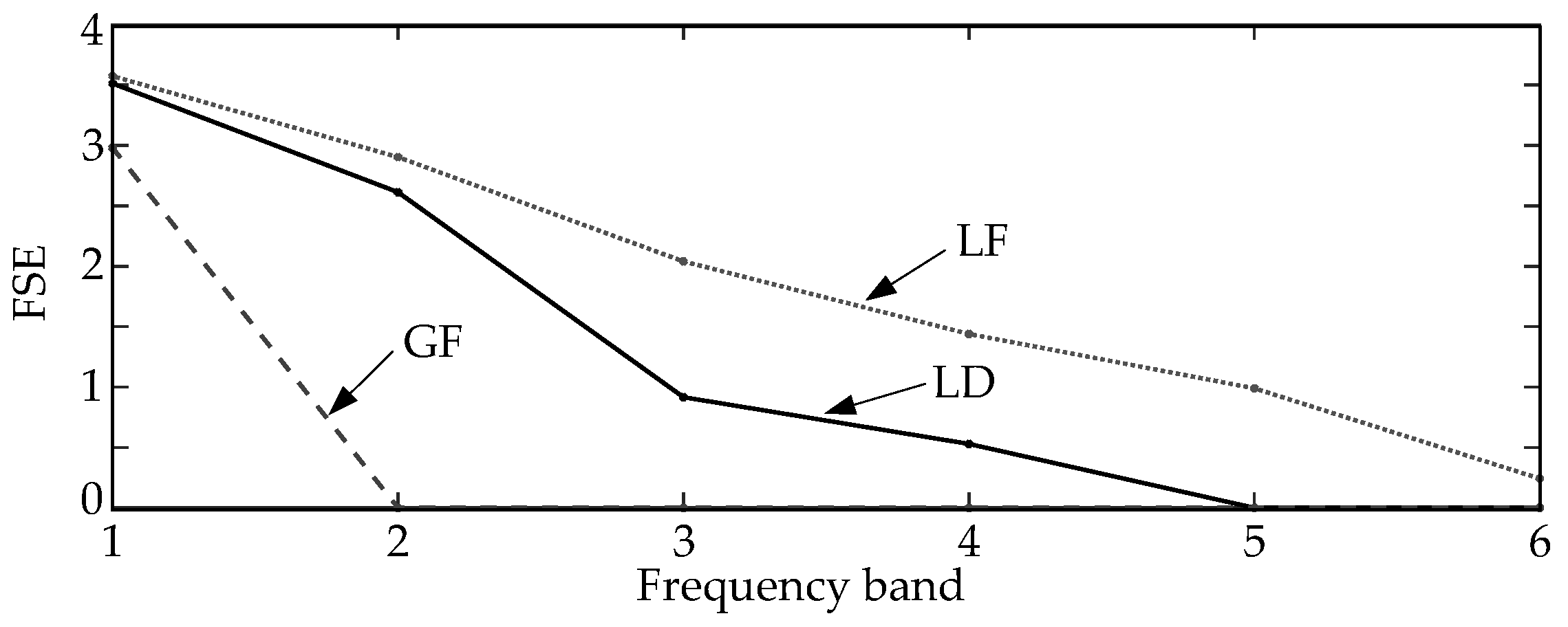Entropy SVM–Based Recognition of Transient Surges in HVDC Transmissions
Abstract
:1. Introduction
2. HVDC and Transient Surges
2.1. Fundamentals of HVDC
2.2. Pole-To-Ground Fault
2.3. Lightning Transients
3. FSE-Based Feature Extraction
3.1. Definantion of FSE
3.2. FSE Representation of Transient Surges
4. SVM-Based Recognition Method
4.1. Foundamentals of SVM
4.2. Recognition Method
5. Simulations
5.1. Simulation Model
5.2. Data Processing
5.3. SVM Training
5.4. Transient Recognition
6. Comparisons
6.1. Comparison of Features
6.2. Comparison of Classifiers
7. Conclusions
Author Contributions
Funding
Conflicts of Interest
References
- Beerten, J.; Cole, S.; Belmans, R. Modeling of multi-terminal VSC HVDC systems with distributed DC voltage control. IEEE Trans. Power Syst. 2014, 29, 34–42. [Google Scholar] [CrossRef]
- Zhang, L.; Harnefors, L.; Nee, H.P. Interconnection of two very weak AC systems by VSC-HVDC links using power-synchronization control. IEEE Trans. Power Syst. 2011, 26, 344–355. [Google Scholar] [CrossRef]
- Li, Y.; Gong, Y.F.; Jiang, B. A novel traveling-wave-based directional protection scheme for mtdc grid with inductive DC terminal. Electr. Power Syst. Res. 2018, 157, 83–92. [Google Scholar] [CrossRef]
- Hao, W.; Mirsaeidi, S.; Kang, X.; Dong, X.; Tzelepis, D. A novel traveling-wave-based protection scheme for LCC-HVDC systems using teager energy operator. Int. J. Electr. Power Energy Syst. 2018, 99, 474–480. [Google Scholar] [CrossRef]
- Song, G.; Chu, X.; Gao, S.; Kang, X.; Jiao, Z. A new whole-line quick-action protection principle for HVDC transmission lines using one-end current. IEEE Trans. Power Deliv. 2015, 30, 599–607. [Google Scholar] [CrossRef]
- Chamia, M.; Liberman, S. Ultra high speed relay for EHV/UHV transmission lines—development, design and application. IEEE Trans. Power Appar. Syst. 1978, 97, 2104–2116. [Google Scholar] [CrossRef]
- Shu, H.C.; Zhang, B.; Zhang, G.B.; Duan, R.M. Identification of lightning disturbance in UHVDC transmission lines using correlation degree based on short time window data. In Materials Science and Information Technology; Zhang, C.S., Ed.; Trans Tech Publications Ltd.: Stafa-Zurich, Switzerland, January 2012; Volume 433–440, pp. 3787–3791. [Google Scholar]
- Kong, F.; Hao, Z.; Zhang, S.; Zhang, B. Development of a novel protection device for bipolar HVDC transmission lines. IEEE Trans. Power Deliv. 2014, 29, 2270–2278. [Google Scholar] [CrossRef]
- Jin, J.X. Protection of HVDC transmission lines based on wavelet transformation and analysis of energy spectrum. In Proceedings of the 2013 2nd International Symposium on Instrumentation and Measurement, Sensor Network and Automation, Toronto, ON, Canada, 23–24 December 2013; IEEE: New York, NY, USA, 2013; pp. 180–185. [Google Scholar]
- Srikanth, P.; Chandel, A.K.; Naik, K.A. HVDC system fault identification using S-transform approach. In Proceedings of the 2010 International Conference on Power, Control and Embedded Systems, Allahabad, India, 29 November–1 December 2010; pp. 1–6. [Google Scholar]
- Stockwell, R.G.; Mansinha, L.; Lowe, R.P. Localization of the complex spectrum: The S transform. IEEE Trans. Signal. Process. 1996, 44, 998–1001. [Google Scholar] [CrossRef]
- Song, G.; Cai, X.; Gao, S.; Suonan, J.; Li, G. Natural frequency based protection and fault location for VSC-HVDC transmission lines. In Proceedings of the International Conference on Advanced Power System Automation and Protection, Beijing, China, 16–20 October 2011; pp. 177–182. [Google Scholar]
- Luo, G.; Lin, Q.; Zhou, L.; He, J. Recognition of traveling surges in HVDC with wavelet entropy. Entropy 2017, 19, 184. [Google Scholar] [CrossRef]
- Sharma, R.; Pachori, R.B.; Acharya, U.R. Application of entropy measures on intrinsic mode functions for the automated identification of focal electroencephalogram signals. Entropy 2015, 17, 669–691. [Google Scholar] [CrossRef]
- Luo, G.; Zhang, D.; Koh, Y.; Ng, K.; Leong, W. Time-frequency entropy-based partial-discharge extraction for nonintrusive measurement. IEEE Trans. Power Deliv. 2012, 27, 1919–1927. [Google Scholar] [CrossRef]
- Lin, S.; Gao, S.; He, Z.; Deng, Y. A pilot directional protection for HVDC transmission line based on relative entropy of wavelet energy. Entropy 2015, 17, 5257–5273. [Google Scholar] [CrossRef]
- Li, H.-F.; Wang, G.; Zhao, J.-C. Study on characteristics and identification of transients on transmission lines caused by indirect lightning stroke. Proc. CSEE 2004, 24, 114–119. [Google Scholar]
- Wu, T.; Bajwa, W.U. Learning the nonlinear geometry of high-dimensional data: Models and algorithms. IEEE Trans. Signal. Process. 2015, 63, 6229–6244. [Google Scholar] [CrossRef]
- Samantaray, S.R.; Dash, P.K.; Upadhyay, S.K. Adaptive kalman filter and neural network based high impedance fault detection in power distribution networks. Int. J. Electr. Power Energy Syst. 2009, 31, 167–172. [Google Scholar] [CrossRef]
- Khorashadi-Zadeh, H. Artificial neural network approach to fault classification for double circuit transmission lines. In Proceedings of the 2004 IEEE/PES Transmision and Distribution Conference and Exposition, Sao Paulo, Brazil, 8–11 November 2004; pp. 859–862. [Google Scholar]
- Butler, K.L.; Momoh, J.A. A neural net based approach for fault diagnosis in distribution networks. In Proceedings of the 2000 Winter Meeting IEEE Power Engineering Society, Singapore, Singapore, 23 January–27 January 2000; Volume 1, pp. 1275–1278. [Google Scholar]
- Praveenkumar, T.; Sabhrish, B.; Saimurugan, M.; Ramachandran, K.I. Pattern recognition based on-line vibration monitoring system for fault diagnosis of automobile gearbox. Measurement 2018, 114, 233–242. [Google Scholar] [CrossRef]
- Jana, S.; De, A. A novel zone division approach for power system fault detection using ANN-based pattern recognition technique. Can. J. Electr. Comput. Eng. 2018, 40, 275–283. [Google Scholar]
- Chen, K.; Hu, J.; He, J. Detection and classification of transmission line faults based on unsupervised feature learning and convolutional sparse autoencoder. IEEE Trans. Smart Grid 2018, 9, 1748–1758. [Google Scholar]
- Geng, P.; Song, J.; Xu, C.; Zhao, Y. Fault pattern recognition method for the high voltage circuit breaker based on the incremental learning algorithms for SVM. In Proceedings of the 2016 International Conference on Condition Monitoring and Diagnosis (CMD), Xi’an, China, 25–28 September 2016; pp. 693–696. [Google Scholar]
- Chen, M.-Y.; Hu, G.; Zhai, J.-Q. High impedance fault detection using hilbert transform and least square support vector machine for distribution feeders. Int. Rev. Electr. Eng. 2012, 7, 4013–4020. [Google Scholar]
- Chang, B.; Cwikowski, O.; Barnes, M.; Shuttleworth, R. Point-to-point two-level converter system faults analysis. In Proceedings of the 7th IET International Conference on Power Electronics, Machines and Drives (PEMD), Manchester, UK, 8–10 April 2014; Institution of Engineering and Technology: Manchester, UK, 2014. [Google Scholar]
- Yang, J.; Zheng, J.-C.; Tang, G.-F.; He, Z.-Y. Grounding design analysis of VSC-HVDC system. Proc. CSEE 2010, 30, 14–19. [Google Scholar]
- Li, H.; Wang, G.; Liao, Z. Distinguish between lightning strikes and faults using wavelet-multi resolution signal decomposition. In Proceedings of the 2004 Eighth IEE International Conference on Developments in Power System Protection, Amsterdam, The Netherlands, 5–8 April 2004; Volume 8, pp. 80–83. [Google Scholar]
- Wang, G.; Li, H.-F.; Zhao, J.-C.; Wu, M. Identification of transients on transmission lines caused by direct lightning strokes based on multiresolution signal decomposition. Proc. CSEE 2004, 24, 139–144. [Google Scholar]
- Warening, J.B. The effects of lightning on overhead lines. In Proceedings of the IEE Seminar on Lightning Protection for Overhead Line Systems, London, UK, 11 December 2000. [Google Scholar]
- Eriksson, A.J.; Meal, D.V.; Stringfellow, M.F. Lightning-induced overvoltages on overhead distribution lines. IEEE Power Eng. Rev. 1982, 2, 41. [Google Scholar] [CrossRef]
- Thottappillil, R.; Uman, M.A. Comparison of lightning return-stroke models. J. Geophys. Res. Atmos. 1993, 98, 22903–22914. [Google Scholar] [CrossRef]
- National Standards Authority of Ireland (NSAI). IEC 61000-4-5 Testingand measurement techniques-surgeimmunity test. In Electromagnetic Compatibility (EMC); CENELEC: Dublin, Ireland, 2014. [Google Scholar]
- Chen, B.D.; Wang, J.J.; Zhao, H.Q.; Principe, J.C. Insights into entropy as a measure of multivariate variability. Entropy 2016, 18, 196. [Google Scholar] [CrossRef]
- Mousavi, M.; Butler-Purry, K. A novel condition assessment system for underground distribution applications. IEEE Trans. Power Syst. 2009, 24, 1115–1125. [Google Scholar] [CrossRef]
- Guo, J.; Chen, Y.; Zhu, M.; Wang, S.; Liu, X. An efficient support vector machine algorithm for solving multi-class pattern recognition problems. In Proceedings of the 2010 Second International Conference on Computer Modeling and Simulation, Sanya, China, 22–24 January 2010; pp. 461–465. [Google Scholar]
- Hsu, C.-W.; Lin, C.-J. A comparison of methods for multiclass support vector machines. IEEE Trans. Neural Netw. 2002, 13, 415–425. [Google Scholar] [PubMed]
- Schwenker, F. Hierarchical support vector machines for multi-class pattern recognition. In Proceedings of the Fourth International Conference on Knowledge-Based Intelligent Engineering Systems and Allied Technologies, Brighton, UK, 30 August–1 September 2000; Volume 562, pp. 561–565. [Google Scholar]
- International Electrotechnical Commission. Protection against Lightning: Risk Management; IEC: Geneva, Switzerland, 2006. [Google Scholar]
- Luo, G.; Zhang, D.; Tseng, K.J.; He, J. Impulsive noise reduction for transient earth voltage-based partial discharge using wavelet-entropy. IET Sci. Meas. Technol. 2016, 10, 69–76. [Google Scholar] [CrossRef]
- Li, X.; Xu, J. The improvement of bp artificial neural network algorithm and its application. In Proceedings of the 2010 International Conference on E-Business and E-Government, Guangzhou, China, 7–9 May 2010; pp. 2568–2571. [Google Scholar]









| Type | Definition |
|---|---|
| linear | |
| polynomical | |
| RBF | |
| sigmoid |
| SVM | Kernel Function | ||||
|---|---|---|---|---|---|
| Liner | Polynomical | RBF | Sigmoid | ||
| Mean recognition rate | SVM1 | 84% | 94% | 95.5% | 81% |
| SVM2 | 100% | 99.5% | 100% | 100% | |
| SVM3 | 100% | 100% | 100% | 100% | |
| SVM | C | γ | Mean Recognition Rate |
|---|---|---|---|
| SVM1 (LD vs. LF) | 5.66 | 1 | 95.5% |
| SVM2 (LD vs. GF) | 0.004 | 0.25 | 100% |
| SVM3 (LF vs. GF) | 0.004 | 0.5 | 100% |
| Type | Recognition Rate | Misjudgment | Overall Recognition Rate |
|---|---|---|---|
| LD | 96% (4/100) | 4 (4 LF) | 97.33% (292/300) |
| LF | 96% (4/100) | 4 (4 LD) | |
| GF | 100% (100/100) | 0 |
| Type | Recognition Rate | Misjudgment | Overall Recognition Rate |
|---|---|---|---|
| LD | 90% (90/100) | 10 (4 GF, 6 LF) | 92.33% (277/300) |
| LF | 100% (100/100) | 0 | |
| GF | 87% (87/1000) | 13 (13 LF) |
| Type | Recognition Rate | Misjudgment | Overall Recognition Rate |
|---|---|---|---|
| LD | 95% (95/100) | 5 (5 GF) | 91.67% (275/300) |
| LF | 80% (80/100) | 20 (20 LD) | |
| GF | 100% (100/100) | 0 |
© 2018 by the authors. Licensee MDPI, Basel, Switzerland. This article is an open access article distributed under the terms and conditions of the Creative Commons Attribution (CC BY) license (http://creativecommons.org/licenses/by/4.0/).
Share and Cite
Luo, G.; Yao, C.; Liu, Y.; Tan, Y.; He, J. Entropy SVM–Based Recognition of Transient Surges in HVDC Transmissions. Entropy 2018, 20, 421. https://doi.org/10.3390/e20060421
Luo G, Yao C, Liu Y, Tan Y, He J. Entropy SVM–Based Recognition of Transient Surges in HVDC Transmissions. Entropy. 2018; 20(6):421. https://doi.org/10.3390/e20060421
Chicago/Turabian StyleLuo, Guomin, Changyuan Yao, Yinglin Liu, Yingjie Tan, and Jinghan He. 2018. "Entropy SVM–Based Recognition of Transient Surges in HVDC Transmissions" Entropy 20, no. 6: 421. https://doi.org/10.3390/e20060421
APA StyleLuo, G., Yao, C., Liu, Y., Tan, Y., & He, J. (2018). Entropy SVM–Based Recognition of Transient Surges in HVDC Transmissions. Entropy, 20(6), 421. https://doi.org/10.3390/e20060421





